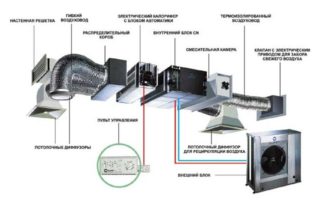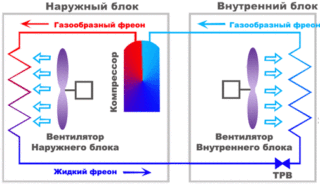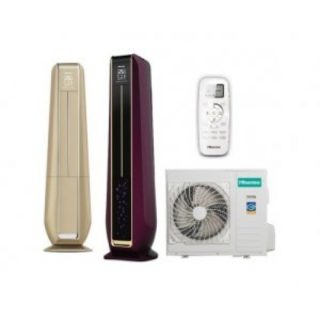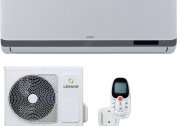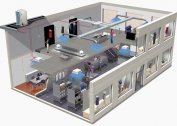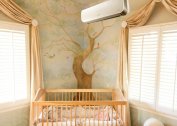One of the components of a pleasant stay in a cafe and restaurant is a comfortable microclimate. A large area of establishments and differences in the requirements for household, administrative premises, a common room and a kitchen make the air conditioning system difficult and expensive. The design for the installation of HVAC equipment must comply with building codes and SES standards. The choice and installation of equipment for cafes and restaurants is best left to professionals.
Types of air conditioning systems for a restaurant
In large restaurants there are three zones with different requirements for ventilation and air conditioning:
- Hall with a dance floor and a bar.
- Kitchen and hot shop.
- Administrative and domestic premises, bathrooms.
Catering facilities of a large area are equipped with industrial air conditioners. Powerful technology provides the necessary level of cooling capacity and cleans the air of impurities and odors. For restaurants, multi-split systems of various types are recommended.
Channel installations
The main feature of the channel-type climate system is the distribution of flows through the ducts. The air conditioner consists of an indoor and outdoor unit, between which refrigerant moves in a closed loop. The indoor module is equipped with a powerful fan to overcome aerodynamic drag in the ducts. Flush mounting of equipment does not violate the interior of the premises. Appliances and air ducts are hidden under a false ceiling.
Advantages of ducted air conditioners:
- simultaneous maintenance of several rooms;
- hidden installation;
- possibility of a combination with forced ventilation.
Minuses:
- the system in all rooms operates in one mode (cooling / heating);
- high installation and design costs are required;
- reduced ceiling height.
Cassette system
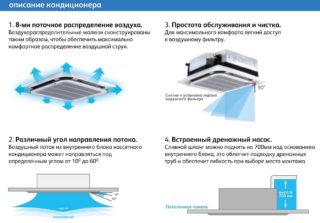 When installing the air conditioning system of the restaurant, a hidden installation form is welcome. Cassette devices are a split system, the internal unit of which is located under a suspended ceiling. A square case is made with a size of 500 × 500 mm to replace one of the tiles of the suspension system. Air is distributed through the decorative panel evenly on four sides.
When installing the air conditioning system of the restaurant, a hidden installation form is welcome. Cassette devices are a split system, the internal unit of which is located under a suspended ceiling. A square case is made with a size of 500 × 500 mm to replace one of the tiles of the suspension system. Air is distributed through the decorative panel evenly on four sides.
Climatic type climatic equipment is designed for room service up to 200 m2.
Advantages:
- the original design of the decorative panel fits organically into the interior;
- the installation copes with cooling and heating large rooms;
- low noise level;
- suitable for rooms of complex configuration.
Minuses:
- high price of equipment;
- installation is carried out only under a suspended ceiling structure.
Chiller fan coil system
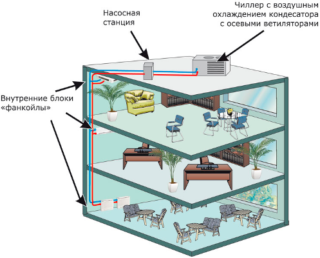 It is advisable to equip the air conditioning in a restaurant with several floors and premises with a chiller-fan coil system. From the refrigerating machine (chiller) through the piping system using a hydraulic unit, cold water is supplied to the fan coil units - heat exchangers with fans. A small investment is required to install the system.
It is advisable to equip the air conditioning in a restaurant with several floors and premises with a chiller-fan coil system. From the refrigerating machine (chiller) through the piping system using a hydraulic unit, cold water is supplied to the fan coil units - heat exchangers with fans. A small investment is required to install the system.
Advantages of the system:
- the distance from the chiller to the fan coils is not limited;
- the use of water as a refrigerant reduces the cost of the pipeline (there is no need to use copper);
- affordable cost.
Minuses:
- design difficulties;
- the need to install additional components: pumps, valves.
Types of air conditioning systems for cafes
Small area establishments need a less powerful climate system. The rooms are installed wall-mounted split systems. This is a standard option consisting of an outdoor and indoor unit. Wall-mounted models are produced by all HVAC companies. Reliable and productive products of Daikin, Mitsubishi Heavy, General brands are suitable for a cafe.
Models with inverter compressor control are more expensive, but they are energy efficient and have a long service life.
Pros of a wall split system:
- a wide selection of design decisions of the internal block;
- compact size;
- affordable cost;
- availability of additional functions;
- possibility of quick installation.
Disadvantages:
- each room is equipped with a separate unit;
- uneven air distribution.
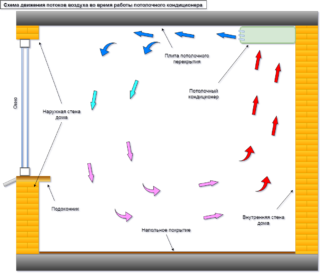 Floor and ceiling model It is installed in the cafe hall if it is not possible to place air conditioning on the wall. A block mounted horizontally on the ceiling directs cold air parallel to the floor. Lowering the temperature in the room is due to natural convection. The second installation option is on the wall near the floor. Airflow is directed vertically.
Floor and ceiling model It is installed in the cafe hall if it is not possible to place air conditioning on the wall. A block mounted horizontally on the ceiling directs cold air parallel to the floor. Lowering the temperature in the room is due to natural convection. The second installation option is on the wall near the floor. Airflow is directed vertically.
Benefits:
- air conditioning serves the room up to 100 m2;
- neat and attractive indoor unit;
- uniform distribution of cold air, which does not cause discomfort to visitors.
Minuses:
- required ceiling height 3 m;
- fresh air is not provided.
Column air conditioners installed in the premises of the cafe, where other options have nowhere to place. They are relevant in interiors with mirrored and glass walls. The appearance of the climate complex resembles a column or cabinet. On the front panel there are blinds for adjusting air flow and a control display. Recommended in halls with an area of 100-140 m2.
Advantages of equipment:
- minimalistic strict design;
- the ability to control the air flow;
- automated control;
- the equipment is characterized by the optimal ratio of energy and productivity;
- does not violate the architectural style of buildings, can be installed in places of historical value.
Disadvantages:
- high price;
- placement features - the column should be located at a distance from people, so as not to overcool visitors.
Features of choice
The size of the initial investment, operating costs and the class of the institution, determined by the level of comfort in the premises, depend on the right choice of climate control equipment. Air conditioning engineers are preparing the project. To select equipment with optimal technical characteristics, initial information about the architectural features of the object is necessary:
- total area;
- building envelope materials;
- number of windows and doors;
- ceiling height;
- floor plan broken down into separate zones.
 When choosing the capacity of climatic equipment, take into account:
When choosing the capacity of climatic equipment, take into account:
- The total number of visitors for which the institution is designed. Air norm 30 m3 / h.
- The staff of the staff. For employees of the institution, a fresh air supply of 60 m3 / h is provided.
- Availability of a smoking area. When choosing the places of installation of the supply and exhaust grilles, the separation of zones is taken into account.
- Heat inflows from all heating and electrical appliances.
- The arrangement of tables in the hall. Air conditioning in a cafe, pub and restaurant depends on the seating plan. Chilled air should not be routed directly to visitors. The use of flush mounting is recommended.
When choosing an air conditioner, its functional potential is taken into account. The equipment should work not only for cold, but also for cleaning and heating the air in the room.
